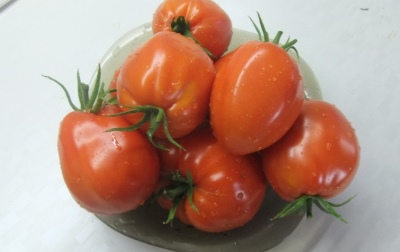
- Authors: Myazina L.A.
- Category: grade
- Growth type: indeterminate
- Appointment: universal
- Ripening period: mid-season
- Ripening time, days: 112-125
- Growing conditions: for open ground, for closed ground, for greenhouses
- Bush size: tall
- Bush height, cm: 160-180
- Branchiness: strong
Tomatoes from the Minusinsk Basin are distinguished by a special bright taste, aroma and a unique balance of sugars, dry and mineral substances, vitamins. All this is due to the special microclimate, the SAT indicator (the sum of active temperatures) and the composition of the soil. One of the magnificent representatives of the Minusinsk family is the indeterminate universal variety Bochkovoy Minusinsk. The tomato is intended for growing in open ground and greenhouses, the fruits are consumed fresh, used for canning, juices and sauces.
Breeding history
The variety owes its appearance to the work of the breeder Lyubov Myazina. She does not use genetic engineering in her work, for which her varieties and hybrids are especially appreciated by gardeners.
Description of the variety
Tall, strongly leafy bushes are prone to extensive branching, reaching a height of 160-180 cm. Shoots are covered with dark green large, weakly corrugated foliage. The Minusinsk barrel has undoubted positive qualities, but it is not devoid of a small and traditional disadvantage.
Advantages | disadvantages |
High yields | Needs tying up |
Amicable maturation | The formation of a large number of stepchildren |
Strong immunity | |
Unpretentious care | |
High content of nutrients | |
Long-term storage | |
Balanced taste |
The main stem gives 5 to 7 clusters, each of which develops from 3 to 5 tomatoes.
The main qualities of the fruit
Beautiful, barrel-shaped and moderately ribbed, large fruits appear puffy and slightly elongated. Milky-green unripe tomatoes at the stage of technical ripeness acquire a red-orange color, weight 250-350 grams.
Taste characteristics
The fruits have excellent performance:
sweet taste;
dense juicy pulp;
the presence of vitamins B, C and K;
the optimal amount of magnesium, sodium, silicon, iodine, iron, phosphorus.
The tomato pulp is covered with a dense oily skin, looks sugary at the break and has a pleasant characteristic aroma.
Ripening and fruiting
The variety is characterized as mid-ripening - ripening period 112-125 days.
Yield
The tomato is a high-yielding tomato - from 9 to 12 kilograms of fruits are harvested from one square meter.
The timing of planting seedlings and planting in the ground
Since the variety is grown in seedlings, the seeds are sown approximately on March 15, and planted in greenhouses in May, after 60-65 days.

Growing tomato seedlings is an extremely important process, because it largely depends on whether the gardener will be able to harvest at all. All aspects must be taken into account, from seedbed preparation to planting in the ground.
Landing scheme
For optimal organization of the life of plants, it is necessary to adhere to a distance between the roots of 30 cm.

Growing and care
The variety is grown in seedlings. For transplanting young plants, the soil should be light, breathable, rich in humus, with an acidity level of about 7 pH. For full development, tomatoes need support - gardeners equip permanent trellises or install stakes for each root. After planting young plants, the soil in the hole is compacted, spilled well with warm water, then loosened the next day. To avoid the appearance of top rot, tomatoes are fed with calcium nitrate - the composition must be added before or after flowering. If the acidity level does not correspond to the norm, then the soil can be deoxidized using bone or dolomite flour.
Caring for tomatoes consists in the mandatory formation of a bush of 1-2 stems and regular weekly watering before the onset of the ripening period. After that, the tomatoes are watered only as needed, since excess moisture at this moment can provoke cracking of the fruit. A high-yielding powerful plant needs enhanced nutrition, therefore, feeding is carried out several times during the growing season. For the first time, nitrogen fertilizers are used, then potassium-phosphorus complex formulations. In addition, tomatoes need organic matter. They get it in the form of infusions of mullein, nettle and weeds. Any infusion should be kept in closed containers until a spicy characteristic smell of the fermented composition appears. The tomato must be tied up as it grows, the lower leaves must be cut off from it, the humidity level must be observed, and ventilation must be organized in order to prevent the appearance of late blight. The growth point is usually pinched when the shoots reach a height of 180-200 cm.No more than three bushes are planted per square meter, otherwise it will be cramped for powerful plants, which will ultimately lead to stagnation of air masses and high humidity.




A plant needs different micronutrients at each stage of growth. All fertilizers can be divided into two groups: mineral and organic. Folk remedies are often used: iodine, yeast, bird droppings, eggshells.
It is important to observe the rate and period of feeding. This also applies to folk remedies and organic fertilizers.
Disease and pest resistance
The plant has a fairly strong immune system and actively resists most diseases typical for nightshades. In order to ensure that crop loss is avoided, it is necessary to carry out prophylaxis, that is, treated with insecticides and fungicides.


Resistant to adverse weather conditions
Tomato belongs to cold-resistant and heat-resistant varieties - it perfectly withstands cold snaps and hot dry weather.
Growing regions
The variety is intended for cultivation in all regions.

























































































